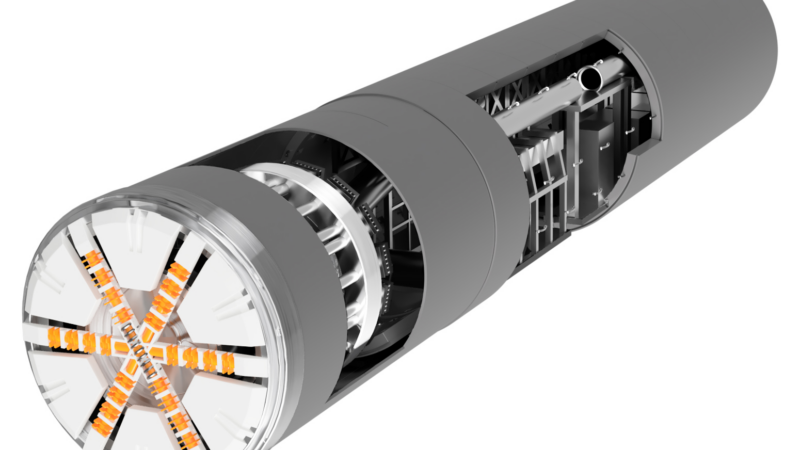The new rope end connection made of plastic is the result from six years of research conducted by the University of Stuttgart. The cover for high-strength fibre ropes is now ready to be put on the market, a prototype is already in use. Its inventors
Lightweight, inexpensive and extremely durable: The novel rope end connection for 4 to 96 mm strong fibre ropes can be subjected to extremely high tensile stress without breaking. Rope end connections are the link between the rope anchorage and the rope itself. The secret lies in the bonding resin and the special type of casting: It is poured onto the exactly clamped and pre-stressed fibres of the rope. Thus, a complete unit of rope and end connections is created which is able to withstand extremely high mechanical forces. „In our numerous tests, we could always reach and even often exceed the minimum breaking force indicated by the rope manufacturer,“ says Dipl.-ing. Sven Winter who developed the novel rope end connection together with Dipl.-Ing. Anita Finckh-Jung at the Institute of Mechanical Handling and Logistics (IFT) of the University of Stuttgart. This invention will open up completely new application areas for high-strength fibre ropes. „Because even the greatest rope is worthless without the appropriate end connection,“ as Sven Winter puts it.
This innovative rope end connection – with patent applications filed in Europe, the US and China – can be used wherever steel cables are to be replaced by high-strength fibre ropes. For example, where the weight does matter or the installation should be as easy as possible. Given the fact that a fibre rope weighs only about an eighth of a steel cable and the combination of cast resin is relatively lightweight, the weight can be reduced by up to 40 percent compared to conventional applications. „This is not an issue when using thin ropes. However, the difference can be huge for ropes with a diameter of up to 96 mm,“ Sven Winter points out. Easy installation is another asset: In the rear part, the rope end connection has a mounting sleeve that can be attached to the lifting device with a few simple steps.
The combination of fibre rope and resin is also extremely durable, as numerous tests have shown. „No matter how often the rope is loaded and relieved, the connection is always stable“, explains Sven Winter. The tension-tension fatigue performance is very good. „We have carried out a four-week test during which the connection was loaded and relieved 1.5 million times. Even after this test the fibre rope sample reached values above the minimum breaking strength of the rope.“ Further advantages include an individually adjustable geometry and the option to integrate sensors for measuring the tractive force or for identification purposes via RFID tags.
About six years have passed from the initial idea to a marketable product. Now the time has come for a know-how transfer from university to industry. „We can imagine many different fields of application and are therefore looking for industrial partners to start implementation,“ explains TLB Innovation Manager Dr.-Ing. Hubert Siller. The University of Stuttgart has entrusted Technologie-Lizenz-Büro (TLB) GmbH with the marketing of its innovation and the global economic implementation of this cutting-edge technology. It could, for example, be used in lifting and conveying equipment, cranes, in bridge construction, in ship technology and offshore applications such as the construction of wind turbines or the anchoring of oil platforms, says Dr.-Ing. Hubert Siller.
The idea for the new rope end connection was conceived during a research project at the IFT of Stuttgart University. „The ingenious idea came to us when we were working on another project with cast resin. We were wondering why you had to intertwine and cover ropes. Why not simply cast them to make them durable?“ inventor Sven Winter shares with us. Together with his colleague Anita Finck-Jung he started to make the first prototype. „Initially, the compound had a breaking force of only 30 percent, but we knew even back then that it had great potential.“ After six years of research and countless tests and modifications, the end connection developed by Winter and Finck-Jung can now bear a breaking force of ropes of up to 96 mm. „There is a large variety of possible applications, from very small to very large ones,“ says Sven Winter. What he needs now are appropriate partners in industry.
Engineer Sven Winter has been testing wire ropes for about 20 years now. Since 2007, he has been in charge of the Rope Technology Division, headed by Prof. Dr.-Ing. Karl-Heinz Wehking, at the Institute of Mechanical Handling and Logistics (IFT). 23 employees from different engineering disciplines work in Winter“s department, which has a 1300 sqm test hall, with various test facilities. Among the customers of IFT“s Rope Technology Division are public institutions, industrial companies and operators of facilities and buildings.
Technologie-Lizenz-Büro (TLB) GmbH supports the University of Stuttgart in patenting and marketing its innovation. Acting on behalf of the University, TLB is in charge of the commercial implementation of this future-orientated technology at a global level. For more detailed information, please contact Dr.-Ing. Hubert Siller, email: siller@tlb.de
Die Technologie-Lizenz-Büro (TLB) GmbH ist eine Agentur für Erfindungs- und Patentmanagement in Deutschland. TLB begleitet Erfindungen von Hochschulen, Unternehmen und Erfindern auf ihrem Weg von der ersten Idee bis zum wirtschaftlichen Produkt.
Kontakt
Technologie-Lizenz-Büro (TLB) GmbH
Annette Siller
Ettlinger Str. 25
76137 Karlsruhe
0721 79004-0
asiller@tlb.de
http://www.tlb.de






